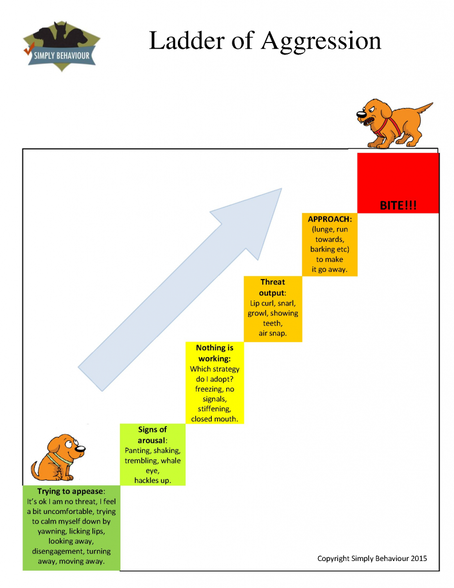
I often have discussions with clients who remark that their dog does not like X. X could be visitors coming to the house, other dogs, kids, cars, the vacuum...
I always ask the owners in these situations,
“what have you done to address the dislike”.
A typical response is
“I tried everything but nothing worked”.
I have discussed this response before. I cringe when I hear it. It is a very loaded statement. “Everything” is an awful lot. “Nothing” is…well…NOTHING.
So I usually ask the owner to elaborate.
When pushed, I usually get responses like
“Well, I have tried correcting the dog” correcting taking the form of yelling, screaming, using squirt bottles or some other negative response. “I have tried removing my dog from the situation” removing meaning placing the dog in a kennel, in another room, or outside. "But none of that has worked".
Hmmmm…
So now we have a couple of ideas that have been tried. They have not worked so “everything has been tried and nothing has worked” is the result. Surely we are better than that.
Let’s examine these methods even superficially...
Where we humans get the idea that we can get a dog over their fear, over their dislike, over their discomfort of something through punishing the dog for their reaction or removing the dog entirely from the situation, is mind boggling.
No wonder it does not work.
All too often, using an aversive response in order to eliminate a negative behaviour has the potential to escalate that negative behaviour to new levels.
Why is this you might ask?
Well, simply put, you are not addressing the root cause of the issue with either of these methods
I wrote a blog on this a while back, if you have not done so, check it out.
For those whose newsfeeds are filled with dog related material, the aggression ladder is a familiar sight. It comes in a variety of forms but all really say the same thing.
The aggression ladder is one that I commonly refer to in training class. If you attempt to eliminate a behaviour such as a growl from a dog’s response tool box through aversive responses, like a correction, the danger is you will eliminate an early warning cue from your dog. It will in turn be replaced by one which is higher on the ladder and often, more dangerous.

So, should one do nothing if your dog is growling at a person?
This is not what I am saying. Of course this behaviour needs to be addressed. However, you should address it by examining the root cause of the growl in such a way that the dog does not feel the need to do so any longer.
To put it in simple terms…if your dog is growling because he does not like visitors coming to the house…find ways to make him like visitors coming to the house. If your dog is lunging at other dogs that pass you on the walking trail because he is scared of other dogs, encourage him to like other dogs.
One of the best and easiest ways of doing this is to encourage the development of positive associations with whatever is troubling your dog.
Break this down into really simple steps. Find out where your dog's comfort level is and start slowly pushing those barriers heavily rewarding the dog each and every time he approaches or even better, surpasses those barriers. Be careful not to flood your dog. Flooding your dog involves pushing your dog too far too fast. If you flood, you are in danger of setting your dog back so far in your training process, your dog may never recover. This is where a good trainer comes into play. A good trainer will be able to help set you up with a plan to ensure your success. If what you are doing is not working, seek help from a professional.
Note that in order to help your dog develop positive associations with something, you need to give and be able to receive immediate feedback to and from your dog. Putting your dog in a kennel, in another room or outside make this impossible to do. Once again however, you do not want to flood your dog so experiment wth short managable durations of exposure and build to longer.
I will use the analogy of learning to swim to emphasize my points
Think of yourself around the water as a kid.
How did you learn to swim?
You probably played around in shallow water using floaties and the like. As your comfort around the water grew, you moved into deeper water playing games, doing handstands, picking up objects off the bottom. As your confidence and skills grew, you moved even deeper, getting further away from the side until you could swim comfortably. Throughout this journey, you were having fun and slowly building your comfort and skill level. Sometimes things got a little scary but there was always safety, control and fun built in to keep you coming back.
Now imagine what would have happened if the first time you were in the shallow end playing around somebody grabbed you and threw you into the deep end. Imagine what would happen if this was forced on you time and again. Imagine if when you protested, you were punished for protesting and still thrown in. Imagine what this does to your psych. How much trust would you have in the person that kept throwing you in? How much would you like the water even if you learned to swim?
Now I want you to relate the above thoughts to your dog learning to deal with situations he is uncomfortable with and how you helped him deal.
The next time you want to address a problem behaviour, I want you to keep this analogy in mind.
You have two choices…
Option one….throw your dog into the deep end and hope he swims without loosing complete trust in, or turning on you
Option two….slowly expose your dog allowing him to build positive associations with whatever he does not like, encourage him to develop skills and coping strategies and confidence in both himself and you all the while having some fun.
Option one may work. It may be quicker. But the potential for negative consequences or other even more more serious behaviours emerging increase exponentially.
Option two has even more potential to work. It may take more time, patience and understanding but there is little likelihood of negative side effects and you may learn something beneficial from the journey.
I know which option is the more appealing to me.